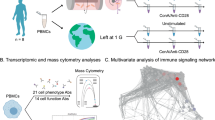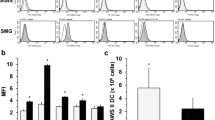Abstract
Immune dysfunction in astronauts is well documented after spaceflights. Microgravity is one of the key factors directly suppressing the function of immune system. However, it is unclear which subpopulations of immune cells including innate and adaptive immune cells are more sensitive to microgravity We herein investigated the direct effects of modeled microgravity (MMg) on different immune cells in vitro. Mouse splenocytes, thymocytes and bone marrow cells were exposed to MMg for 16 hrs. The survival and the phenotypes of different subsets of immune cells including CD4+T cells, CD8+T cells, CD4+Foxp3+ regulatory T cells (Treg), B cells, monocytes/macrophages, dendritic cells (DCs), natural killer cells (NK) were determined by flow cytometry. After splenocytes were cultured under MMg for 16h, the cell frequency and total numbers of monocytes, macrophages and CD4+Foxp3+T cells were significantly decreased more than 70 %. MMg significantly decreased the cell numbers of CD8+ T cells, B cells and neutrophils in splenocytes. The cell numbers of CD4+T cells and NK cells were unchanged significantly when splenocytes were cultured under MMg compared with controls. However, MMg significantly increased the ratio of mature neutrophils to immature neutrophils in bone marrow and the cell number of DCs in splenocytes. Based on the cell survival ability, monocytes, macrophages and CD4+Foxp3+Treg cells are most sensitive to microgravity; CD4+T cells and NK cells are resistant to microgravity; CD8+T cells and neutrophils are impacted by short term microgravity exposure. Microgravity promoted the maturation of neutrophils and development of DCs in vitro. The present studies offered new insights on the direct effects of MMg on the survival and homeostasis of immune cell subsets.








Similar content being viewed by others
References
Allebban, Z., Ichiki, A.T., Gibson, L.A., Jones, J.B., Congdon, C.C., Lange, R.D.: Effects of spaceflight on the number of rat peripheral blood leukocytes and lymphocyte subsets. J. Leukoc. Biol. 55(2), 209–213 (1994). Available from http://www.ncbi.nlm.nih.gov/pubmed/8301218
Borchers, A.T., Keen, C.L., Gershwin, M.E.: Microgravity and immune responsiveness: Implications for space travel. Nutrition 18(10), 889–898 (2002). Available from http://www.ncbi.nlm.nih.gov/pubmed/12361784
Chapes, S.K., Morrison, D.R., Guikema, J.A., Lewis, M.L., Spooner, B.S.: Cytokine secretion by immune cells in space. J. Leukoc. Biol. 52(1), 104–110 (1992). Available from http://www.ncbi.nlm.nih.gov/pubmed/1640164
Chen, H., Zhang, L., Zhang, H., Xiao, Y., Shao, L., Li, H., Yin, H., Wang, R., Liu, G., Corley, D., Yang, Z., Zhao, Y.: Disruption of tsc1/2 signaling complex reveals a checkpoint governing thymic cd4 + cd25 + foxp3 + regulatory t-cell development in mice. FASEB journal : official publication of the Federation of American Societies for Experimental Biology 27(10), 3979–3990 (2013). Available from http://www.ncbi.nlm.nih.gov/pubmed/23882125. doi:10.1096/fj.13-235408
Cichocki, F., Sitnicka, E., Bryceson, Y.T.: Nk cell development and function–plasticity and redundancy unleashed. Semin. Immunol. 26(2), 114–126 (2014). Available from http://www.ncbi.nlm.nih.gov/pubmed/24594002. doi:10.1016/j.smim.2014.02.003
Cogoli, A., Tschopp, A., Fuchs-Bislin, P.: Cell sensitivity to gravity. Science 225(4658), 228–230 (1984). Available from http://www.ncbi.nlm.nih.gov/pubmed/6729481
Crucian, B., Stowe, R., Mehta, S., Uchakin, P., Quiriarte, H., Pierson, D., Sams, C.: Immune system dysregulation occurs during short duration spaceflight on board the space shuttle. J. Clin. Immunol. 33(2), 456–465 (2013). Available from http://www.ncbi.nlm.nih.gov/pubmed/23100144. doi:10.1007/s10875-012-9824-7
Crucian, B.E., Cubbage, M.L., Sams, C.F.: Altered cytokine production by specific human peripheral blood cell subsets immediately following space flight. J. Interferon. Cytokine. Res. 20(6), 547–556 (2000). Available from http://www.ncbi.nlm.nih.gov/pubmed/10888111. doi:10.1089/10799900050044741
Fooksman, D.R., Vardhana, S., Vasiliver-Shamis, G., Liese, J., Blair, D.A., Waite, J., Sacristan, C., Victora, G.D., Zanin-Zhorov, A., Dustin, M.L.: Functional anatomy of t cell activation and synapse formation. Annu. Rev. Immunol. 28, 79–105 (2010). Available from http://www.ncbi.nlm.nih.gov/pubmed/19968559. doi:10.1146/annurev-immunol-030409-101308
Gould, C.L., Lyte, M., Williams, J., Mandel, A.D., Sonnenfeld, G.: Inhibited interferon-gamma but normal interleukin-3 production from rats flown on the space shuttle. Aviat. Space Environ. Med. 58(10), 983–986 (1987). Available from http://www.ncbi.nlm.nih.gov/pubmed/3118864
Gratz, I.K., Campbell, D.J.: Organ-specific and memory treg cells: Specificity, development, function, and maintenance. Front. Immunol. 5, 333 (2014). Available from http://www.ncbi.nlm.nih.gov/pubmed/25076948. doi:10.3389/fimmu.2014.00333
Hashemi, B.B., Penkala, J.E., Vens, C., Huls, H., Cubbage, M., Sams, C.F.: T cell activation responses are differentially regulated during clinorotation and in spaceflight. FASEB journal : official publication of the Federation of American Societies for Experimental Biology 13(14), 2071–2082 (1999). Available from http://www.ncbi.nlm.nih.gov/pubmed/10544190
Hu, X., Liu, G., Hou, Y., Shi, J., Zhu, L., Jin, D., Peng, J., Zhao, Y.: Induction of m2-like macrophages in recipient nod-scid mice by allogeneic donor cd4(+ )cd25(+ ) regulatory t cells. Cell. Mol. Immunol. 9(6), 464–472 (2012). Available from http://www.ncbi.nlm.nih.gov/pubmed/23085944. doi:10.1038/cmi.2012.47
Limouse, M., Manie, S., Konstantinova, I., Ferrua, B., Schaffar, L.: Inhibition of phorbol ester-induced cell activation in microgravity. Exp. Cell. Res. 197(1), 82–86 (1991). Available from http://www.ncbi.nlm.nih.gov/pubmed/1915666
Liu, G., Hu, X., Sun, B., Yang, T., Shi, J., Zhang, L., Zhao, Y.: Phosphatase wip1 negatively regulates neutrophil development through p38 mapk-stat1. Blood 121(3), 519–529 (2013). Available from http://www.ncbi.nlm.nih.gov/pubmed/23212517. doi:10.1182/blood-2012-05-432674
Luo, H., Wang, C., Feng, M., Zhao, Y.: Microgravity inhibits resting t cell immunity in an exposure time-dependent manner. Int. J. Med. Sci. 11(1), 87–96 (2014). Available from http://www.ncbi.nlm.nih.gov/pubmed/24396290. doi:10.7150/ijms.7651
Mermel, L.A.: Infection prevention and control during prolonged human space travel. Clin. Infect. Dis. 56(1), 123–130 (2013). Available from http://www.ncbi.nlm.nih.gov/pubmed/23051761. doi:10.1093/cid/cis861
Mills, P.J., Meck, J.V., Waters, W.W., D’Aunno, D., Ziegler, M.G.: Peripheral leukocyte subpopulations and catecholamine levels in astronauts as a function of mission duration. Psychosom. Med. 63(6), 886–890 (2001). Available from http://www.ncbi.nlm.nih.gov/pubmed/11719626
Miyara, M., Ito, Y., Sakaguchi, S.: Treg-cell therapies for autoimmune rheumatic diseases. Nat. Rev. Rheumatol. 10(9), 543–551 (2014). Available from http://www.ncbi.nlm.nih.gov/pubmed/24980140. doi:10.1038/nrrheum.2014.105
Pecaut, M.J., Simske, S.J., Fleshner, M.: Spaceflight induces changes in splenocyte subpopulations: Effectiveness of ground-based models. Am. J. Physiol. Regul. Integr. Comp. Physiol. 279(6), R2072–2078 (2000). Available from http://www.ncbi.nlm.nih.gov/pubmed/11080071
Qu, Y., Zhao, Y.: Regulatory cd4(+ )cd25(+ ) t-cells are controlled by multiple pathways at multiple levels. Int. Rev. Immunol. 26(3-4), 145–160 (2007). Available from http://www.ncbi.nlm.nih.gov/pubmed/17558742. doi:10.1080/08830180701365917
Schmitt, D.A., Hatton, J.P., Emond, C., Chaput, D., Paris, H., Levade, T., Cazenave, J.P., Schaffar, L.: The distribution of protein kinase c in human leukocytes is altered in microgravity. FASEB journal: official publication of the Federation of American Societies for Experimental Biology 10(14), 1627–1634 (1996). Available from http://www.ncbi.nlm.nih.gov/pubmed/9002555
Stolp, J., Turka, L.A., Wood, K.J.: B cells with immune-regulating function in transplantation. Nature reviews. Nephrology 10(7), 389–397 (2014). Available from http://www.ncbi.nlm.nih.gov/pubmed/24846332. doi:10.1038/nrneph.2014.80
Sun, B., Hu, X., Liu, G., Ma, B., Xu, Y., Yang, T., Shi, J., Yang, F., Li, H., Zhang, L., Zhao, Y.: Phosphatase wip1 negatively regulates neutrophil migration and inflammation. J. Immunol. 192(3), 1184–1195 (2014). Available from http://www.ncbi.nlm.nih.gov/pubmed/24395919. doi:10.4049/jimmunol.1300656
Sun, C., Sun, L., Ma, H., Peng, J., Zhen, Y., Duan, K., Liu, G., Ding, W., Zhao, Y.: The phenotype and functional alterations of macrophages in mice with hyperglycemia for long term. J. Cell. Physiol. 227(4), 1670–1679 (2012). Available from http://www.ncbi.nlm.nih.gov/pubmed/21678423. doi:10.1002/jcp.22891
Taylor, G.R.: Overview of spaceflight immunology studies. J. Leukoc. Biol. 54(3), 179–188 (1993). Available from http://www.ncbi.nlm.nih.gov/pubmed/8371047
Taylor, G.R., Neale, L.S., Dardano, J.R.: Immunological analyses of u.S. Space shuttle crewmembers. Aviat. Space Environ. Med. 57(3), 213–217 (1986). Available from http://www.ncbi.nlm.nih.gov/pubmed/3485967
Wang, C., Luo, H., Zhu, L., Yang, F., Chu, Z., Tian, H., Feng, M., Zhao, Y., Shang, P.: Microgravity inhibition of lipopolysaccharide-induced tumor necrosis factor-alpha expression in macrophage cells. Inflamm. Res. 63(1), 91–98 (2014). Available from http://www.ncbi.nlm.nih.gov/pubmed/24196691. doi:10.1007/s00011-013-0676-2
Wang, H., Zhao, L., Sun, Z., Sun, L., Zhang, B., Zhao, Y.: A potential side effect of cyclosporin a: Inhibition of cd4(+ )cd25(+ ) regulatory t cells in mice. Transplantation 82(11), 1484–1492 (2006). Available from http://www.ncbi.nlm.nih.gov/pubmed/17164721. doi:10.1097/01.tp.0000246312.89689.17
Yamada, H., Damiano, V.V., Tsang, A.L., Meranze, D.R., Glasgow, J., Abrams, W.R., Weinbaum, G.: Neurtrophil degranulation in cadmium-chloride-induced acute lung inflammation. Am. J. Pathol. 109(2), 145–156 (1982). Available from http://www.ncbi.nlm.nih.gov/pubmed/6923702
Zeng, C., Shi, X., Zhang, B., Liu, H., Zhang, L., Ding, W., Zhao, Y.: The imbalance of th17/th1/tregs in patients with type 2 diabetes: Relationship with metabolic factors and complications. J. Mol. Med. 90(2), 175–186 (2012). Available from http://www.ncbi.nlm.nih.gov/pubmed/21964948. doi:10.1007/s00109-011-0816-5
Zhang, L., Zhao, Y.: The regulation of foxp3 expression in regulatory cd4(+ )cd25(+ )t cells: Multiple pathways on the road. J. Cell. Physiol. 211(3), 590–597 (2007). Available from http://www.ncbi.nlm.nih.gov/pubmed/17311282. doi:10.1002/jcp.21001
Zheng, Q., Xu, Y., Liu, Y., Zhang, B., Li, X., Guo, F., Zhao, Y.: Induction of foxp3 demethylation increases regulatory cd4 + cd25 + t cells and prevents the occurrence of diabetes in mice. J. Mol. Med. 87(12), 1191–1205 (2009). Available from http://www.ncbi.nlm.nih.gov/pubmed/19841877. doi:10.1007/s00109-009-0530-8
Zheng, W., Wang, Q.H., Feng, H., Liu, J., Meng, H.R., Cao, Y.M.: Cd4 + cd25 + foxp3 + regulatory t cells prevent the development of th1 immune response by inhibition of dendritic cell function during the early stage of plasmodium yoelii infection in susceptible balb/c mice. Folia Parasitol. (Praha) 56(4), 242–250 (2009). Available from http://www.ncbi.nlm.nih.gov/pubmed/20128236
Zhu, L., Yang, T., Li, L., Sun, L., Hou, Y., Hu, X., Zhang, L., Tian, H., Zhao, Q., Peng, J., Zhang, H., Wang, R., Yang, Z., Zhang, L., Zhao, Y.: Tsc1 controls macrophage polarization to prevent inflammatory disease. Nat. Commun. 5, 4696 (2014). Available from http://www.ncbi.nlm.nih.gov/pubmed/25175012. doi:10.1038/ncomms5696
Acknowledgments
We thank Mrs Jianxia Peng for her expert technical assistance, Mrs Yanli Hao for her excellent laboratory management. This work was supported by grants from the National Basic Research Program of China (2011CB710903, 2010CB945301, YZ), the National Natural Science Foundation for General and Key Programs (C81130055, U0832003, YZ; C31200681, HL) the Strategic Pioneer Project on Space Science of Chinese Academy of Sciences (XDA04020202-19, YZ), and the CAS/SAFEA International Partnership Program for Creative Research Teams (Y.Z.)
Competing interests
The authors declared that no competing interest exists.
Author information
Authors and Affiliations
Corresponding author
Electronic supplementary material
Below is the link to the electronic supplementary material.
Rights and permissions
About this article
Cite this article
Chen, H., Luo, H., Liu, J. et al. The Distinctive Sensitivity to Microgravity of Immune Cell Subpopulations. Microgravity Sci. Technol. 27, 427–436 (2015). https://doi.org/10.1007/s12217-015-9441-1
Received:
Accepted:
Published:
Issue Date:
DOI: https://doi.org/10.1007/s12217-015-9441-1




